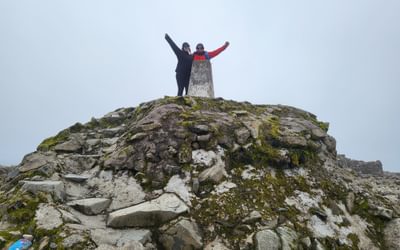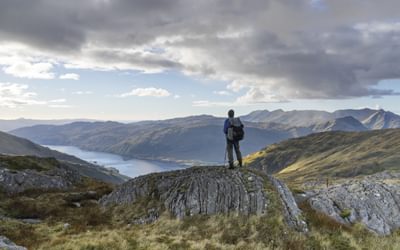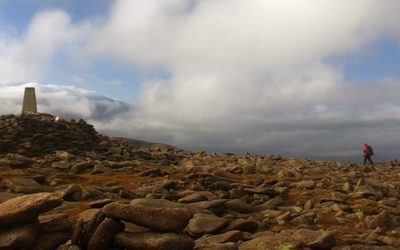Dipping a toe in the Cairngorms – a backpacking adventure in the Scottish mountains
If you are looking for a chance to escape the office and find real remoteness in the UK, then the Cairngorms are calling! Few other places in Britain bring out that primal feeling of being alone in the wilderness more than these mountains.
The Cairngorms was the last major mountainous area on the UK mainland that I hadn’t trekked. As it’s renowned as the toughest, I was incredibly excited to see what all the fuss was about. My friend Andrew was a novice trekker and had never wild camped before. He had asked me to plan an adventure: and where better or more remote than the Cairngorms? It was to be slightly challenging for a first-timer…
We flew from London to Inverness, then hopped on the train to Aviemore. This sounds expensive, but can be done for very little if you book well in advance. We stayed at the High Range campsite in Aviemore and took the first bus to the Ski Centre early next morning. Here we did final checks, sorted out maps, confirmed the plan with Andrew and, crucially, made our Snickers bars easily accessible for the epic adventure ahead.
Day 1
We found the path heading south and began an ascent which would eventually take us to Ben Macdui, the second highest peak in the UK. The first thing to strike me was the vivid red vegetation: you often see these vibrant colours in photographs but I had always assumed these had been digitally enhanced. Clearly this was not the case, and as we pressed on we were gradually engulfed by the red mountains. We had initially been sheltered from the worst of the wind, providing an enjoyable and tranquil ignorance that almost felt like we were strolling up Pen Y Fan.
Then, as we passed Coire an Lochain to our left, the wind rose and the Cairngorms demonstrated why they have a reputation as the hardest hills in the UK.
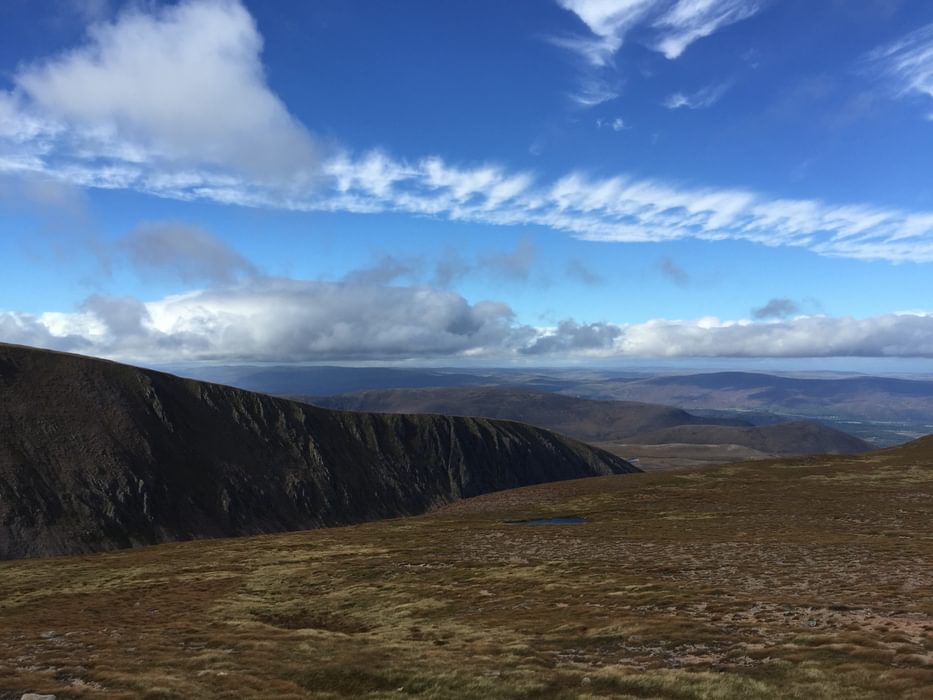
Battling through a 40mph headwind, we eventually reached a marshy area upstream of March Burn and sheltered behind some rocks to devour our lunch and contemplate the last few hours of battering from the wind. Although not particularly cold there was a significant chill factor to the wind, and it felt around 0°C: the rocks by the burn were a welcome shelter.
Ben Macdui was to be Andrew’s first Munro: a tall one to start with, but that made it all the better as we left our lunch spot and ascended, following the compass into the clouded heights of the Cairngorms.
The summit of Ben Macdui was constantly in and out of cloud, so we didn’t linger. Coming off the eastern side we followed the track towards Loch Etchachan and found a picturesque camp spot with running water and shelter from the wind.
I had packed a feast, justified by the fact that eating it would get the heavy and bulky meal out of the way before we started on lighter rations. Wild camping has its perks: we woke at dawn to a fantastic view of Little Loch Etchachan and Loch Etchachan, and felt like we could have been days away from civilisation: rugged, natural scenery stretched as far as the eye could see in all directions.
Day 2
We headed east down the valley beside Coir Etchachan Burn. Passing the Hutchinson Memorial Bothy, we were glad we’d camped the night before: the bothy was full, and four tents were scattered outside. As the river bent south our route took us through Glen Derry, one of the most beautiful areas of the whole trip. Half of this glacial valley is devoid of vegetation, before becoming an oasis of shrubs and trees lining lush river banks. Apart from at the bothy we had only seen one person that day, and in the glen we felt once more as if we were many miles from civilisation.
That feeling of being remote and alone is addictive, and you begin to question why we waste so much time on phones and Facebook when we could be running around mountains.
The weather brightened up, the wind dropped and the sun made its debut appearance, providing increasingly stunning surroundings that seemed ablaze when caught by the light. At the bottom of Glen Derry is the Derry Lodge, where a maze of streams meets. It is necessary to cross at least one of them the old fashioned way: a chilly wade across the largest but shallowest section was refreshing, to say the least. On the far bank we picked up a track heading west through a stunning and dead-silent pine forest, finding red squirrels and a golden eagle – the first time I had seen either wild in the UK. It was 5km (as the crow flies) to our turning point north, where we would follow the River Dee up to the Corrour Bothy. We hoped to find a place to stay there as we had received, for a fleeting moment, the overnight weather forecast: it looked grim, to say the least.
The bothy was full and there were three tents pitched outside, but it was a good place to be nevertheless, as the weather was forecast to deteriorate that evening and there were no other sites suitable for a tent nearby. We also wanted to be near the bothy to give us the option of attacking Devil’s Point, an intimidating rock face with a jagged and eye-catching outline, the next day: this is reached via a steep, non-technical route from the northern side. I had hoped prior to departing to be able to do the formidable Braeriach traverse, which follows the beautiful but very exposed ridge line of The Devil’s Point, Cairn Toul, Sgor an Lochain Uain and Braeriach. This, however, was out of the question: one of the guys staying near the bothy warned us of 80+mph winds coming in for the next day, with heavy rain and bad visibility. That wind could literally blow you off such a treacherous route, and there are very few exit options once up there.
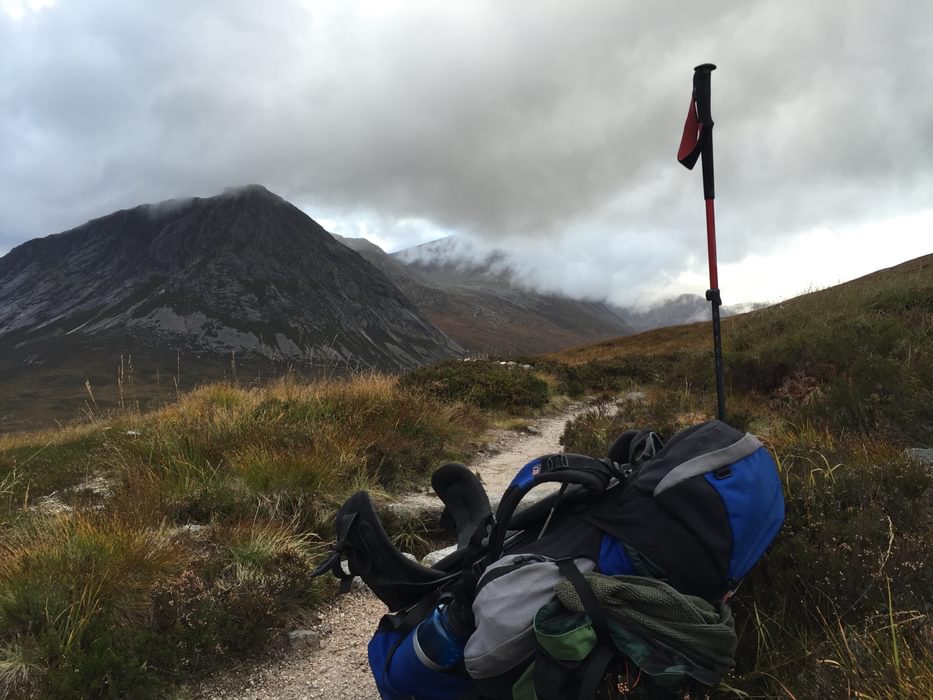
Day 3
So the next morning, after a night long barrage of wind and heavy rain, we packed up for Plan B, which was to continue North from the Corrour Bothy, hand-railing the River Dee. This was, to no surprise, gruelling! A headwind of over 50mph, with faster gusts, came hurtling through the valley out of nowhere, supplemented by driving rain. This morning was most definitely Type 2 fun! Eventually getting bowled over by the wind became rather comical, particularly if you were observing at just the right time and it was someone else who was being floored.
There was some shelter at the top of the valley, near the Pools of Dee, and we enjoyed a respite while savouring a few moments for lunch. But it was getting late, and we were nowhere near to finding a campsite that afforded appropriate protection from the wind which, as we had neared the top, had begun to come from opposite directions as the air rushed in from both ends of the valley. We had made far slower progress on this stretch than anticipated, so we knew we may well have to compromise on the suitability of a spot for camping. This is where bivouac bags would have been invaluable.
Continuing north, passing the valley’s now towering sides and precarious-looking scree slopes, the wind found us once more. As Andrew began to tire my efforts to find a spot became more frantic: if we were stuck in an exposed area in 50mph winds the tent would struggle to survive. After checking numerous places we made the decision to head for the forest directly north, beside the Allt Druidh, where the map showed flat ground and some cover. This area turned out to be absolutely stunning: the red landscape was as lush as ever, and in between clouds the sunlight caught the vegetation and seemed to set it on fire.
If it hadn’t have been getting late we would have spent hours around the northern end of the Lairig Ghru valley, drinking in the scenery. Instead we hurriedly pressed on, finding in the forest a degree of shelter and a scattering of small branches and twigs, which looked like someone’s earlier attempt to build a windbreak. Fortunately the wind had brought down a lot of other branches and vegetation, we had a plentiful supply of resources to build the wall up. We were situated just above the very steep drop down to the Allt Druidh river, from which gusts would come through at well over 50mph. Although it is not advisable to camp under a tree in these winds, the branches above us were stable and we were severely limited for alternatives.
We built a 4½ft wall of criss-crossed dead branches, plugged the gaps with heather and supported the now heavy structure with extra cross and vertical pieces. It must have stopped most of the wind, but gusts would still get round it and at times we felt as if it was going to lift the tent up and away into the darkness. As we tried to sleep it was all we could do to hope we would wake up inside the tent in a few hours.
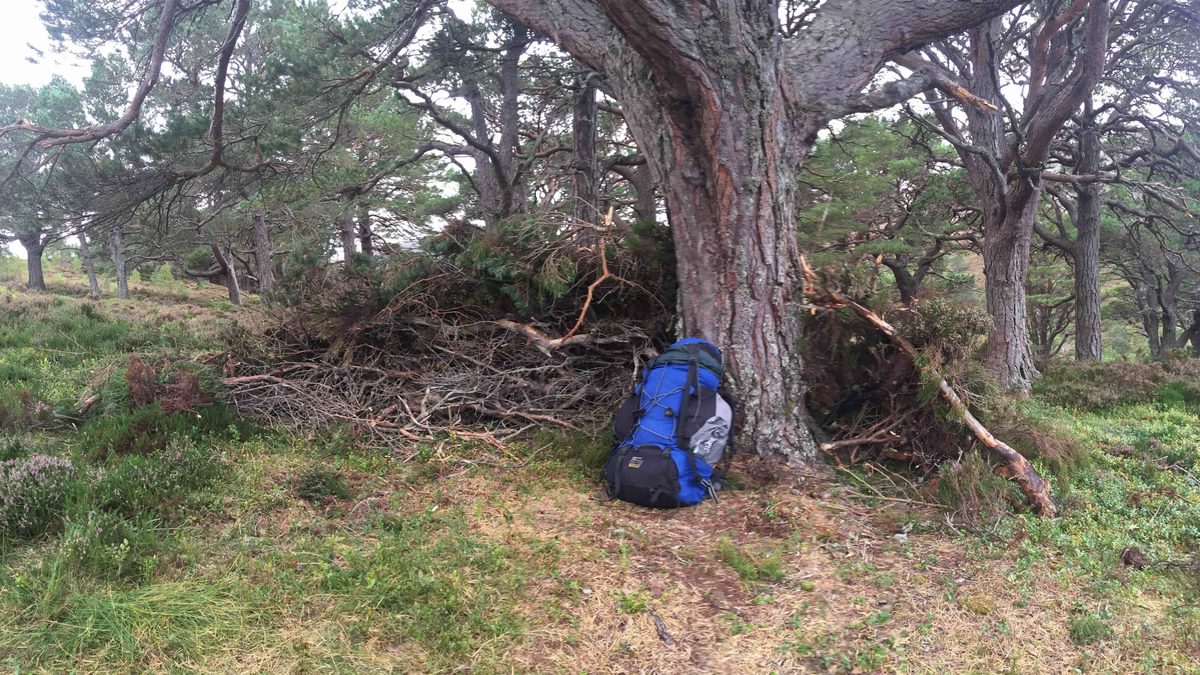
Day 4
Come morning, we were alive and in a tent! We had grown used to the wind and had managed to sleep a couple of hours.
We quickly packed up and headed through the forest to Rothiemurchus Lodge and up through Eag a’ Chair, looking for reindeer in their enclosure. There weren’t any paths this way, so we headed up through tough terrain, eventually finding the fence line, but no reindeer. It was also rutting season (September–November), so a trip into the enclosure to find a reindeer would probably have been short-lived!
We meandered back to the Ski Centre, gutted to be leaving such a landscape and our sense of independence behind, but looking forward to some Type 1 fun (fresh food and beer). Next time, I promised myself, I would come for longer.

Scottish Wild Country Backpacking
30 weekend and multi-day routes in the Highlands and Islands
£25.00
30 wild and challenging backpacking routes in Scotland. Aimed at experienced and self-reliant backpackers, routes are between 2 and 4 days long and traverse the remotest, wildest and most spectacular landscapes the Highlands and Islands have to offer. The book also covers equipment, access, weather, safety and first aid.
More informationTo read more articles like this get our newsletter
Sign up for 20% off your next purchase and to be the first to hear about exclusive competitions, special offers, and news from Cicerone.







